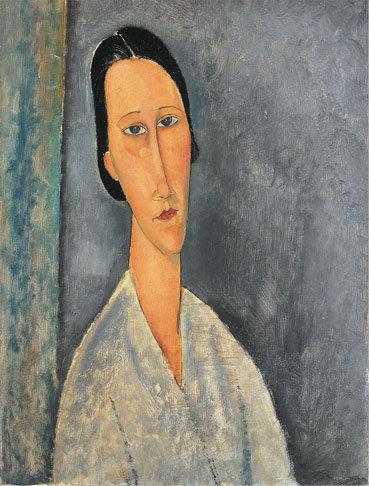Modigliani and His Times
dal 4/2/2008 al 17/5/2008
Segnalato da
4/2/2008
Modigliani and His Times
Museo Thyssen-Bornemisza, Madrid
Retrospective

Modigliani and His Times presents a survey of the work of Amedeo Modigliani (1884–1920) from the moment of his arrival in Paris in 1906 up to his premature death at the age of 35. Although focusing on a single creator, it includes not only Modigliani’s most important works—primarily paintings, along with sculptures and drawings— but also those by artists from his social and professional circles. It has thus been structured into two principal sections devoted to Modigliani’s relationships with his masters and with his friends.
Shortly after his arrival in Paris in 1906, Modigliani enrolled at the Académie Colarossi and also visited the leading galleries of the day, where he saw works by Gauguin, Van Gogh, Toulouse-Lautrec, Cézanne, Matisse, and the young Picasso. Following his first contacts with the Paris art world, Modigliani not only realised that his academic training had been of little or no use to him, but also encountered the total rejection of earlier art on the part of the emerging avant-garde in the French capital.
Modigliani's early years in Paris coincided with various retrospectives that would be of crucial importance for the subsequent development of modern art, including those on Gauguin and Cézanne organised by the Salon d'Automne in 1906 and 1907 respectively. Cézanne's work confirmed Modigliani's own interest in the art of the Old Masters combined with the use of a completely modern artistic idiom.
Few works from Modigliani's earliest years in Paris have survived, largely due to the fact that he had to leave his various studios hurriedly when he was unable to pay the rent. The pieces on display here bring to light the way in which the artist began to develop his own style, inspired by the examples of Cézanne, Gauguin, Toulouse-Lautrec, Munch, and Picasso.
Prior to his arrival in Paris, Modigliani had already expressed his intention of becoming a sculptor. The example of African art was a turning point in this sense, and in 1908 he executed his first studies of heads and caryatids inspired by African masks. In 1909 Modigliani moved to Montparnasse, the area at that time replacing Montmartre as the centre of the Parisian art world. It was there that he met the Romanian sculptor Constantin Brancusi, who encouraged him to take up direct carving in stone. For around five years, Modigliani almost completely abandoned painting and devoted himself to sculpture, at first using hard materials such as marble, then softer ones such as sandstone, which he aimed to endow with a massive and timeless look. Modigliani's efforts as a sculptor would be fundamental to the consolidation of his mature style as a painter.
The outbreak of World War I placed Modigliani in a difficult situation. In addition to the problem of how to launch his sculptures on the market, the fact that the construction industry was paralysed made it impossible for him to find blocks of stone to work. Moreover, his delicate health meant that he was increasingly sensitive to the stone dust that irritated his lungs. When the writer Max Jacob introduced Modigliani to the art dealer Paul Guillaume that summer of 1914, the artist had not yet completely abandoned sculpture. However, he opted for painting and thus embarked on his future development as a portraitist.
Modigliani's earliest portraits of 1914 still reveal the influence of Fauve colour. Next follow works in which the Cubist approach to spatial organisation prevails. In 1917 Modigliani formulated his mature style characterised by a synthesis of line and volume. In contrast to other 20th-century artists such as Derain, Picasso, and Gris, Modigliani always maintained a balance in his representations between the formal structure of the work and a faithful depiction of the sitter's particular appearance. Among the most important pictures on display in this exhibition are those of the painters Diego Rivera and Juan Gris, the Jewish writer Max Jacob, Madame Zborowska, and Modigliani's lover Jeanne Hébuterne.
Modigliani had painted female nudes from the time of his arrival in Paris. His first works were notably expressive and conformed to the Symbolist idea of the female body as a source of sin. Later, his nudes lost this moralising content and embraced a Mediterranean sensuality.
In 1917 and with the consolidation of his mature style, Modigliani began his popular series of reclining nudes on the request of his friend and new dealer, Léopold Zborowski, who aimed to sell them to collectors interested in the newest type of avant-garde art. However, the thirty or so works painted in Zborowski's apartment between 1917 and 1919 did not meet with the anticipated interest. In these works Modigliani looked to the example of earlier nudes, from Giorgione's Venus to Goya's Naked Maja, flattening the female form in a way first used by Ingres and ultimately adopted by Picasso. Most notable, however, is their erotic charge, which reflects the spirit of sexual liberty prevailing in Montparnasse in the second decade of the century and which shocked many of those who saw these paintings.
Museo Thyssen-Bornemisza
Paseo del Prado, 8 - Madrid



